|
 Hygrocybe procera Hygrocybe procera
SynonymsHygrophorus procerus
Hygrocybe procera
BiostatusPresent in region - Indigenous. Endemic
Images (click to enlarge)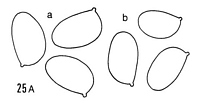
Caption: Hygrocybe procera (Stev.): (type): a. spores. - b. spores of H. miniceps Stev. (type) | 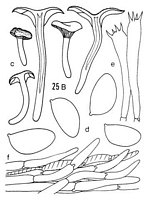
Caption: Hygrocybe procera (Stev.): c. carpophores. - d. spores. - e. basidia. - f. cuticle (Herb. HK. ZT68/119) | 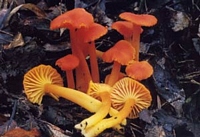
Caption: Hygrocybe procera
Owner: Kaimai Bush | 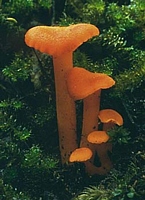
Caption: Hygrocybe procera
Owner: Kaimai Bush | 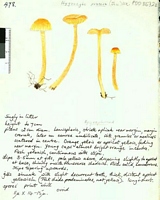
Caption: Watercolour
Owner: G.M. Taylor | 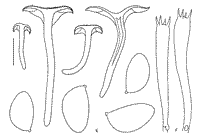
Caption: Fig. 6 Hygrocybc procera (Stev.) Horak. (D-F: ZT 68/119): D.
basidiomesE. spores. F. basidia. | 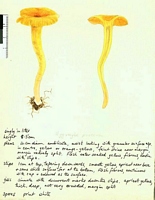
Caption: Watercolour
Owner: G.M. Taylor | 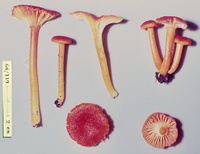
Caption: ZT68-119
Owner: E. Horak: © Creative Commons Attribution-Noncommercial 3.0 New Zealand | 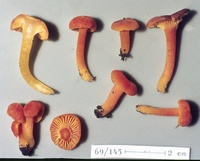
Caption: ZT69-145
Owner: E. Horak: © Creative Commons Attribution-Noncommercial 3.0 New Zealand | 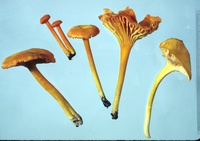
Caption: ZT71-080
Owner: E. Horak: © Creative Commons Attribution-Noncommercial 3.0 New Zealand | 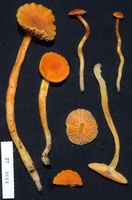
Caption: ZT9664
Owner: E. Horak: © Creative Commons Attribution-Noncommercial 3.0 New Zealand | 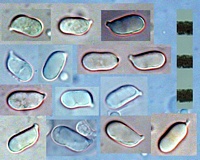
Owner: J.A. Cooper | 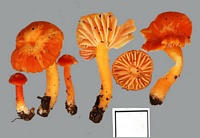
Owner: J.A. Cooper | 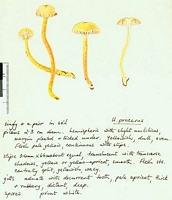
Caption: Watercolour
Owner: G.M. Taylor |  | 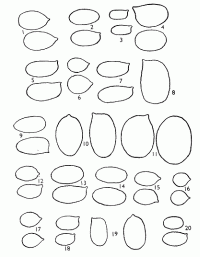
Caption: Spores X 2000 1. Hygrophorus salmonipes 2; H. elsae; 3, H .julietae; 4, H. variabilis; 5, H. lilaceo-lamelllatus; 6, H. muritaiensis; 7, H. keithgeorgei; 8, H. pseudococcineus; 9, H. rubro-carnosus; 10, H. miniceps; 11, H. procerus; 12, H. multic | |
Article: Horak, E. (1990). Monograph of the New Zealand Hygrophoraceae (Agaricales). New Zealand Journal of Botany 28(3): 255-306 (http://www.rsnz.org/publish/abstracts.php).
Description: Pileus -50 mm, hemispherical to plano-convex at first becoming expanded to
depressed, occasionally infundibuliform; brilliant red-orange or orangeyellow,
fading with age; dry, coarsely fibrillose to squamulose, free end of scaly fibrils
(concolorous or paler on drying) appressed or upturned, margin nonstriate, hygrophanous.
- Lamellae 8-16 (1-3) rather distant, broadly adnate to decurrent-arcuate, up
to 6 mm wide; yellow, orange or red-orange, concolorous or paler at obtuse,
edges entire. - Stipe 15-70 x`3-6 mm, cylindrical, equal or attenuated towards
base; dry, glabrous to minutely fibrillose,
hollow, single or caespitose. - Context red-orange in pileus, yellow in stipe.
- Odour and taste not distinctive. - Chemical reactions on pileus: KOH, HCI,
and NH3 - negative.
Spores 11-17 x 7-10 um, distinctly amygdaliform. –Basidia 55-75 x 8-12 um,
4-(rarely 2-) spored. - Cystidia absent. - Pileipellis a trichoderm of cylindrical,
suberect hyphae (8-14 um diam.), membrane not gelatinised, with encrusting or
plasmatic pigment, clamp connections present (Pl.1, Fig. 1).
Habitat: ECOLOGY: Common; saprobic on soil among litter in Leptospermum scoparium
or Kunzea ericoides and in broadleaved-conifer forests (Beilschmiedia,
Metrosideros, Weinmannia, Dacrydium, Agathis). February-June.
Distribution: DISTRIBUTION: NZ (NA, W, WL, STI).
Article: Horak, E. (1971). A contribution towards the revision of the Agaricales (Fungi) from New Zealand. New Zealand Journal of Botany 9(3): 403-462 (http://www.rsnz.org/publish/abstracts.php).
Notes: Hygrophorus procerus Stevenson (28 D) = Hygrocybe procera (Stevenson)
comb. nov. (Basionym: H. procerus Stevenson, Kew Bull. 16: 380, 1962)
Article: Stevenson, G. (1963) [1962]. The Agaricales of New Zealand: IV. Kew Bulletin 16(3): 373–384.
Description: Pileus 1-2-5 cm., diam., orange to luteous, darker at centre, often striate
at edge, hemispherical, matt to subfibrillose; flesh orange to yellow, rather
waxy. Gills sinuately adnexed to adnate, orange, paler at edges, deep, distant,
rather thick. Stipe 5-7 cm. X 2-3 mm. yellow to orange, smooth, silky to waxy,
hollow to somewhat stuffed, rather tough, flesh continuous with that of cap;
centre of cap is a separate plug of tissue above hollow centre of stipe. Spores
10 x 14-17 µm., hyaline, thin-walled, print white. Basidia 80-85 X 9-12 µm.,
four-spored.
Habitat: habitat: in
soil under forest, Keith George Park, 15.6.1949; & 26-6. 1958; Levin, 22.6.1958;
Silverstream, 19.7-1949; all Stevenson.
Article: Horak, E. (1973). Fungi Agaricini Novazelandiae I-V. Beihefte zur Nova Hedwigia 43: 200 p.
Description: Pileus 5-50 mm diam., scarlet, deep red-orange or orange-luteous hemispherical when young, later becoming expanded with low umbilicus fibrillose to minutely scaly, fibrils concolorous, squamules free and upturned or appressed, margin estriate, dry. Lamellae adnate to decurrent, red-orange to orange paler at the edges, distant. Stipe 15-70 x 3-6 mm, cylindric, equal or attenuated towards the base, red-orange to orange, paler near the base, smooth, dry, hollow. Context red-orange, yellow in the stipe. Odor and taste not distinctive. Chemical reactions on pileus: KOH, NH3 and HCl - negative.
Spores 11-17 x 7-10 µm, ellipsoid to amygdaliform, smooth, inamyloid. Basidia 55-75 x 8-12 µm, 4- and rarely also 2-spored. Cystidia absent. Cuticle consisting of cylindric, not gelatinized hyphae (8-14 µm diam.) forming a cutis, tips of hyphae suberect, epimembranous and/or plasmatic pigment present. Clamp connections numerous.
Habitat: In soil under Beilschmiedia, Dacrydium, Weinmannia, Metrosideros, etc., occasionally also under Nothofagus. New Zealand.
Notes: In New Zealand this is a widely distributed and easily recognized species which occurs mainly in Podocarpus and broad leaved forests but is rarely seen in Nothofagus associations. Macroscopically H. procera . (Stev.) resembles H. intermedia (Pass.) or H. marchii (Bres.) but its large spores definitely separate it from the two European fungi. With respect to the size of the spores, the squamulose pileus and the colours, H. procera appears to be closely related with H. pseudococcineus Hongo (1955). Unfortunately no type material was available to compare the two taxa, which also have some relationships with H. suzukaensis Hongo (1962). However, the latter species differs in having a glabrous and non scurfy pileus.
All characters found on the type material of H. miniceps Stevenson (1962) . also described from New Zealand indicate that this fungus is conspecific with H. procera (Stev.).
|